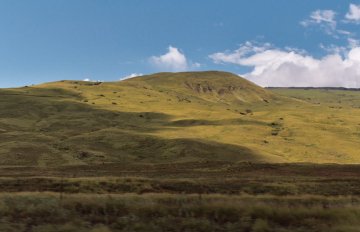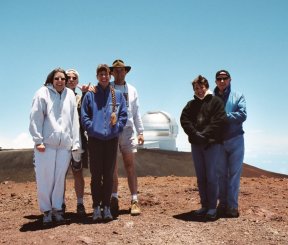| Mauna Kea, Hawaii 13796 feet |
Climbed 6/12/2004 |
As the highest point in the Pacific, Mauna Kea is a perfect place for astronomical observatories: above the clouds, not much ambient light. There are twelve observatories on the top of Mauna Kea. Conveniently, the presence of the observatories means there is a road to the summit. A dirt road, yes, but a road nonetheless.
We went to Mauna Kea during our twentieth anniversary trip to Hawaii. The drive to Mauna Kea requires a 4-wheel drive vehicle. On the day of our summit attempt, we swapped the van we had been driving for an SUV. Our route took us into the hilly grasslands of the Parker Ranch, which looked more like northern California than Hawaii, then along the saddle road between Mauna Kea and Mauna Loa.

This is Hawaii?
After passing through a military training area, we turned onto the summit road. The landscape became more volcanic and barren as our SUV climbed toward the Onizuka Visitor Center at 9300 feet. We stopped at the Visitor Center for a while to acclimate — we were at sea level a couple of hours ago! When we were breathing easily, we drove slowly up the winding dirt road to the observatories near the summit. We parked next to the University of Hawaii telescope, piled on our warm clothes, and climbed over the guardrail for a short hike to the true summit. From the top, we could see the patches of snow still clinging to the ground. We took pictures to commemorate the achievement and watched the clouds creeping up the slopes toward us.

Bundled up on the summit